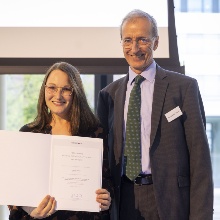On April 18, 2024, the employers' association Südwestmetall honored a total of eight young scientists from Baden-Württemberg's state universities for their outstanding dissertations. The award-winning dissertations are distinguished by their notable relevance to the industrial world of work and its socio-political framework conditions. These prizes have been awarded for more than 35 years and are endowed with 5,000 euros each.
Once again, a scientist from the University of Stuttgart was among this year's winners: Dr. Kathrin Pollmann received the award for her exemplary dissertation, completed at the Institute of Human Factors and Technology Management IAT on "A Human-Centered Pattern Approach to Comprehensible and Pleasant Behavioral Expressions for Social Robots". Pollmann explains: "I deal with user-centered technology design. This means that the core of my research is people and how they interact with technology. Psychological, ethical and social aspects also play a role here, for example. I am delighted that this interdisciplinary approach convinced the jury.”
Pollmann already worked at the Fraunhofer Institute for Industrial Engineering IAO whilst writing her dissertation and continued her career at the institute after obtaining her doctorate. Her research approach enables the simplification and standardization of non-verbal communication between humans and robots. "Technology must serve people and not the other way around. My vision is robots that are intuitive and easy for anyone to operate - without having to read a thick manual first," says Pollmann.
Simplification and standardization of non-verbal communication
When we think of robots, stereotypical images come to mind: From the industrial robot on the production line to the metal companion in a magic show to the robot vacuum cleaner at home. Things get more exciting when humans and robots communicate and work together. Human-robot interaction (MRI) opens up a wide range of possibilities: What would it be like if service robots helped us with our shopping at the supermarket? Or if they showed us the right way in a city? How should such a robot behave so that its human counterpart understands it even without speech?
Kathrin Pollmann addressed these questions in her dissertation from 2019 to October 2023. The aim of her research is to simplify and standardize non-verbal communication between humans and robots. "When people communicate with each other, they are constantly sending small signals, such as a raised eyebrow or a nod of agreement, which are interpreted and understood in a fraction of a second. A robot first has to learn how to communicate without words," explains Pollmann. In the same way, a robot's human counterpart has to learn how it "ticks". This harbors a lot of potential for misunderstandings.
Kathrin Pollmann has developed a solution that will not only help users to better understand robots in the future but also provides developers with the basic building blocks required to instruct robots on appropriate behavior in specific situations. Her approach SHAPE_HRI (Englisch: Approach to Social beHAvioral PattErn Design for Human-Robot Interaction) is a design process that provides steps and tools to generate reusable robot behaviors. "I first looked at existing robot applications and analyzed them to identify recurring situations.
One example of this is listening, symbolized by glowing ears," explains Pollmann. Based on these analyses, she has derived design recommendations to enable robots robot to interact in such a way that people understand what is meant. These recommendations can easily be adapted to suit different types of robots. Pollmann has developed a notation format to document a uniform and standardized representation of behavioral patterns in an understandable and comprehensible way. A pattern language describes the relationships between the different patterns. Central to her work is the pattern wiki, a repository that catalogues all developed robot behavior patterns. Pollmann has also developed a software development kit that supports the transfer of these patterns to specific robots.
Pattern Wiki: Library for behavioral patterns in human-robot interaction
The pattern wiki was created as part of the "NIKA" project. This focused on determining the social behavior that a robot should exhibit when interacting with older people to offer them optimal support in their daily lives, while also being perceived as likable. Based on the requirements and needs of older people, Pollmann has developed interaction strategies for three different types of robot: Abstract, animal-like and humanoid. This gave rise to the idea for her dissertation to develop standardized design recommendations for robot users and build up a library of design patterns. In the future, the pattern wiki will not only help the research team at Fraunhofer IAO with interaction design for social robots, but will also be opened up to other experts involved in interaction design and software development in the field of robotics. They will then continue to expanded this together.
You can find a video about Dr. Kathrin Pollmann on the Südwestmetallpresse website
Contact

Lena Jauernig
Editor Research / Early Career Researchers



